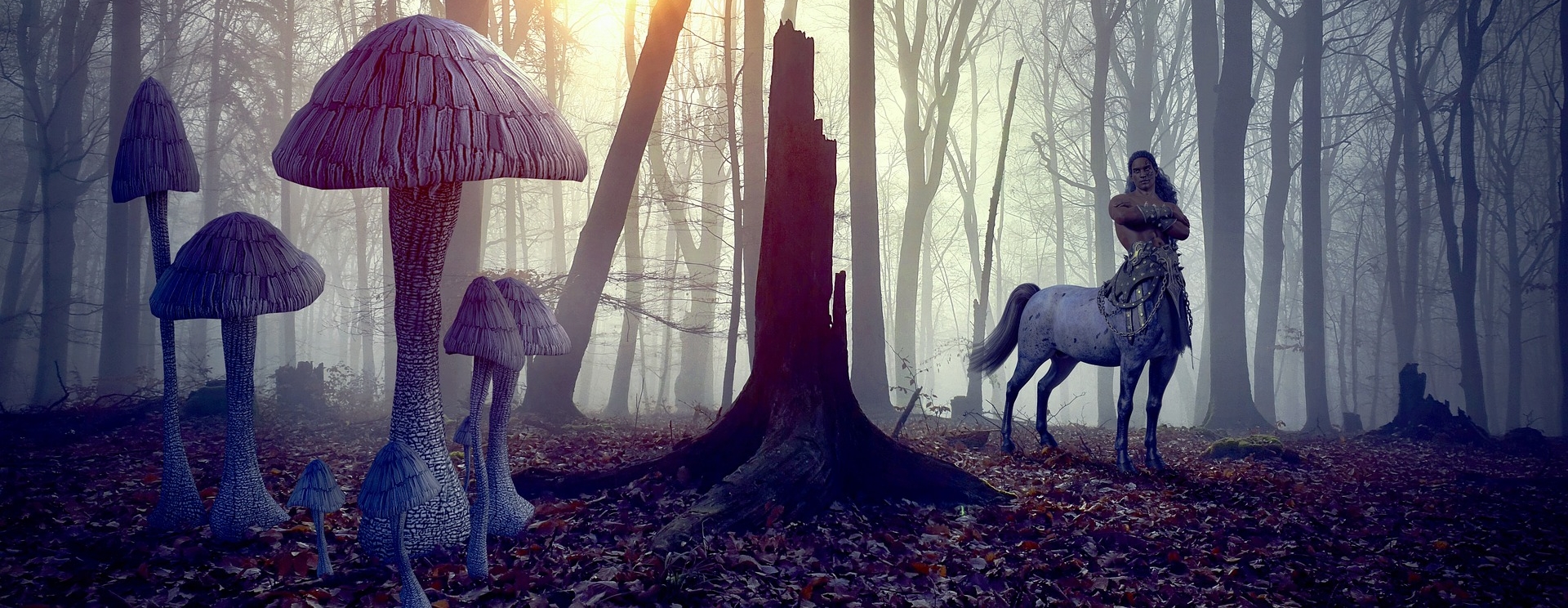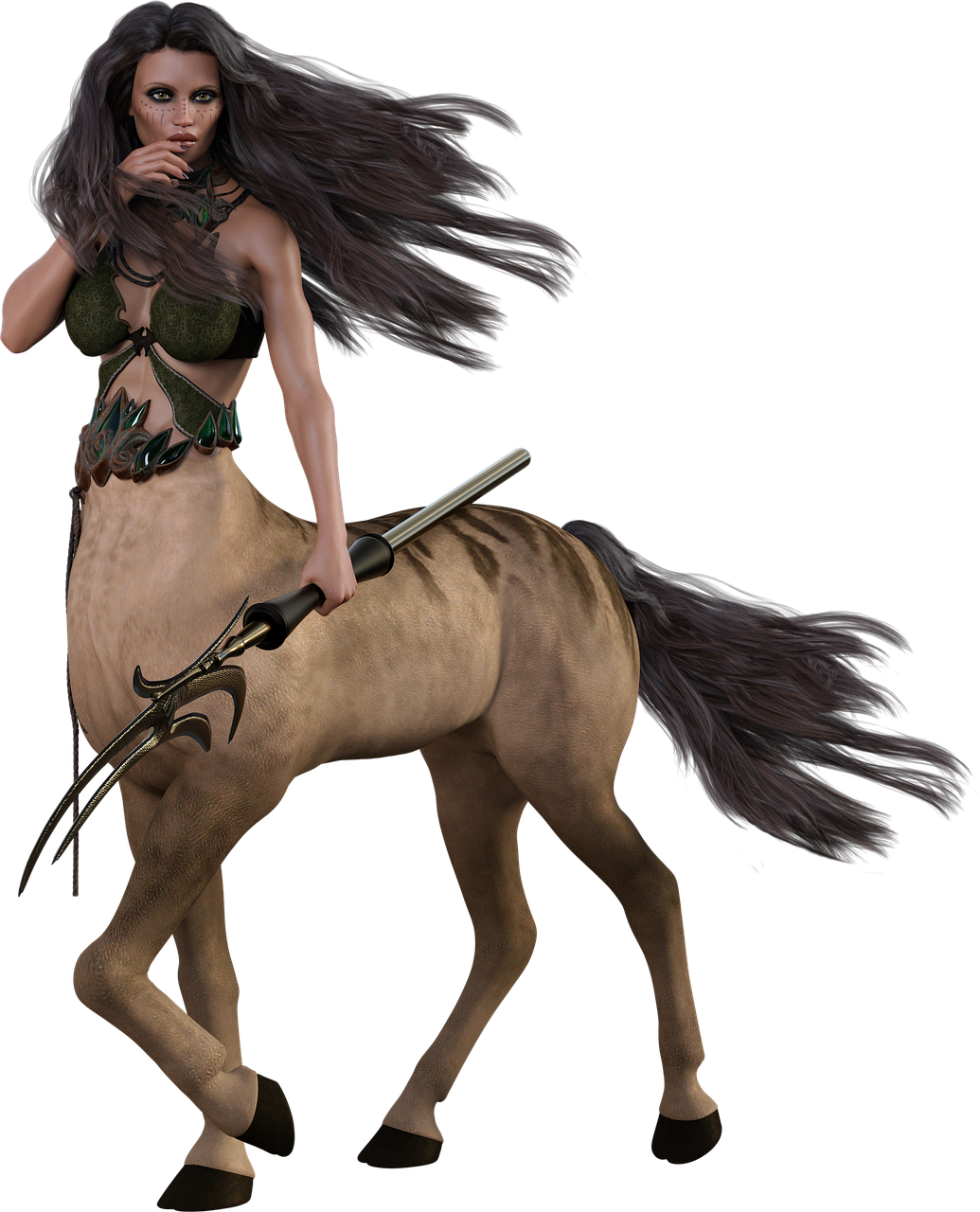The Centaur
Centaurs are a convergent blend of human and horse, a palpable symbol to the dichotic polarity between civilization and wilderness. As such, they exist on the fringes of both. They are not among the awakened species of Athea, but formed from spirit magic when the White Rock fell. Thus, they are of the fae.
However, unlike the fae creatures, centaurs are not immortal, their physical form being flesh and blood. They eat, drink, reproduce, and love, living full lives before lying down for their eternal sleep. Though they love the wild, fiercely protecting the purity of the lands from any despoiling interlopers, they are by nature communal, forming close-knit tribal societies.
In the early days, the centaur suffered a miserable existence. The reason and logic of their sentient mind was in constant conflict with their wild bestial spirit. It took many centuries for the two to finally harmonize and evolve centaurs into the noble creatures they have become today.
The typical lifespan of a centaur is about 50 years. During the their youth, They tend to form wandering herds, roaming the far reaches of the wilderness as self designated guardians of the land. A nomadic herd can be found in almost any natural environment, though they tend to dislike the cold.
But a nomadic life can be harsh, and wanderlust tends to fade with age. It is common for centaurs to settle reclusive villages among rolling hills or forested glens, always near a fresh water source. Residing in these communities are the tribal leaders, the wise, the elderly, and the young. Centaur tribes tend to be matriarchal, with leaders chosen by renown, and it is in the villages where centaur customs are upheld.
Their laws are simple and exacted without prejudice, with the more serious crimes punishable by exile from the tribe and its territory. The tribal councils determine guilt or innocence by vote. Once the verdict is final, the criminal is branded, ostracized, and released to find their own fate. Other minor crimes are self-monitored and settled privately between themselves. Community shame is the biggest deterrent of any ill doings.
A centaur values their reputation among their herd-mates above all else. All centaurs view feats of combat and physical prowess as paths to such renown and they fear failure of these attributes more than they fear death in battle. Thus, they are fierce and formidable warriors that easily capitalize on their size and strength. A centaur in full battle lust is as intimidating as it gets.
But as fierce as they are, centaurs are an equally benign species full of love, laughter and peace. The well-being of the land, their tribe, their friends and loved ones is paramount, and they would fight to the death or die to defend that which they hold dear.
Chain 375 gp 100 pounds
Ring 175 gp 80 pounds
Leather 75 gp 50 pounds
251-300 pounds = 15 (10 sq)
301-350 pounds = 12 (8 sq)
351-400 pounds = 9 (6 sq)
401-450 pounds* = 6 (4 sq)
451-500 pounds** = 3 (2 sq)
501-550 pounds** = 1 (1sq)
*Can carry for a number turns equal to Constitution ability score. Then a Constitution check is required each turn. Failure = fatigue and must stop to rest the amount of turns traveled. When carrying this amount of weight, - 3 to all attack rolls. **Can carry for a number rounds equal to Constitution ability score. Then a Constitution check is required each round thereafter. Failure equals damage to joints and loss of hit points equal to the number of rounds traveled plus Constitution score. Must rest a number of days equal to the total amount of rounds traveled. When carrying this amount of weight, - 5 to all attack rolls.
Combat
Inflexible Joints: Centaurs receive no Dexterity bonus modifier to Armor Class. Bigger is Better: Centaurs add +2 to melee damage rolls vs. small to medium creatures and deal normal damage vs. large or bigger creatures. Charge: If a Centaur charges at least 60 feet straight toward a target and then hits it with a cavalry melee weapon (ie, cavalry mace, cavalry flail, lance, spear, club, etc.) attack on the same turn, the target takes double the damage (plus any damage modifiers). A charging Centaur gains a +2 to attack roll, mainly from momentum, and they suffer an AC penalty of -2 for that round.There is none so fearsome as a charging centaur brimmed with the lust of battle. Their wild screams and bestial visage alone is enough to curdle the blood, but if they wield lance or spear, better to have your affairs in order.With the exception of the centaur's intended target, all other opponents in melee range gain an automatic attack of opportunity. And if a defender is using a spear or pole arm weapon and sets it against the charge (bracing the butt against a stone or ground), they inflict double damage on a successful hit. A charge must be announced before movement at the beginning of the combat round. If the Centaur pulls out of a charge during the run, they lose their action for the round. Hooves: Centaurs may attack with their front hooves for 2d4 damage. Bucking Attack: Centaurs may use rear hooves for a bucking attack for 2d6 damage. If successful, a bucking attack has a 10% chance per level (never more than 99%) of stunning small, medium, and large creatures for 1d4 rounds. However, bucking attacks require the Centaur to expose their flanks, losing any shield bonus to Armor Class until the next round. If the bucking attack fails that opponent and any adjacent opponents get an attack of opportunity (may also include rear attack and/or flanking modifiers if applicable). Trample: A Centaur may attempt to trample a small, medium, or large downed opponent for 2d6.
Armor
Centaur armor is heavier, more costly, and is considered horse barding. Use S&W Armor table for AC rating of armor (pg. 31 S&W Handbook). Note: Centaurs can not wear barding unless they have assistance donning it and/or removing it. Donning barding takes 20 minutes with one assistant. For each additional assistant, cut the time in half. Hastily removing barding takes 5 minutes. Removing and storing it correctly, 20 minutes.Centaur Barding
Plate 500 gp 140 poundsChain 375 gp 100 pounds
Ring 175 gp 80 pounds
Leather 75 gp 50 pounds
Movement/Encumbrance
Centaurs use the following chart for movement (see S&W Handbook pg 32). Base Movement Rate = 18 Up to 250 pounds = 18 (12 sq)251-300 pounds = 15 (10 sq)
301-350 pounds = 12 (8 sq)
351-400 pounds = 9 (6 sq)
401-450 pounds* = 6 (4 sq)
451-500 pounds** = 3 (2 sq)
501-550 pounds** = 1 (1sq)
*Can carry for a number turns equal to Constitution ability score. Then a Constitution check is required each turn. Failure = fatigue and must stop to rest the amount of turns traveled. When carrying this amount of weight, - 3 to all attack rolls. **Can carry for a number rounds equal to Constitution ability score. Then a Constitution check is required each round thereafter. Failure equals damage to joints and loss of hit points equal to the number of rounds traveled plus Constitution score. Must rest a number of days equal to the total amount of rounds traveled. When carrying this amount of weight, - 5 to all attack rolls.
Centaur Classes: Fighter, Ranger, Druid.
Alignment: Lawful, Neutral.
Size: Large (7-8 ft tall / 2100-2400 lbs).
-Centaurs receive +2 hp/level -During character creation, centaurs receive+2 to their strength ability score (max 18). -During character creation, centaurs receive -2 to their dexterity ability score (Min 3).
As omnivores, centaurs require a minimum of 25-30 pounds of food per day to fuel their large equine bodies.
Due to the intake limitations of having a human mouth, centaurs are constantly hungry and must eat frequently.
Diet consists mainly of fruits, nuts, vegetables and other plants, however, centaurs also require meat proteins to sustain muscle growth.
Alignment: Lawful, Neutral.
Size: Large (7-8 ft tall / 2100-2400 lbs).
-Centaurs receive +2 hp/level -During character creation, centaurs receive+2 to their strength ability score (max 18). -During character creation, centaurs receive -2 to their dexterity ability score (Min 3).
Dietary Needs And Habits
Due to the intake limitations of having a human mouth, centaurs are constantly hungry and must eat frequently.
Diet consists mainly of fruits, nuts, vegetables and other plants, however, centaurs also require meat proteins to sustain muscle growth.
Lifespan
50-60 years
Average Height
6-8 feet tall
2-3 feet human torso
4-5 feet tall equine body
Average Weight
1500-1800 pounds
Average Length
5-7 feet long
36-48 inch equine girth
50-60 years
Average Height
6-8 feet tall
2-3 feet human torso
4-5 feet tall equine body
Average Weight
1500-1800 pounds
Average Length
5-7 feet long
36-48 inch equine girth






Comments